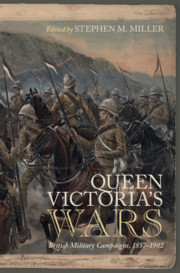Book contents
- Queen Victoria’s Wars
- Queen Victoria’s Wars
- Copyright page
- Contents
- Maps
- Contributors
- Acknowledgements
- 1 Introduction
- 2 The Indian Rebellion, 1857–1858
- 3 Punitive Expeditions in China, 1857–1860
- 4 The Expedition to Abyssinia, 1867–1868
- 5 The New Zealand Wars, 1845–1872
- 6 The Third Anglo-Asante War, 1873–1874
- 7 The Second Afghan War, 1878–1880
- 8 The Anglo-Zulu War, 1879
- 9 The First Anglo-Boer War, 1880–1881
- 10 Egypt and the Sudan, 1881–1885
- 11 The Third Anglo-Burmese War and the Pacification of Burma, 1885–1895
- 12 The Tirah Campaign, 1897–1898
- 13 Reconquest of the Sudan, 1896–1898
- 14 The South African War, 1899–1902
- 15 Conclusion
- Index
- References
11 - The Third Anglo-Burmese War and the Pacification of Burma, 1885–1895
Published online by Cambridge University Press: 01 June 2021
- Queen Victoria’s Wars
- Queen Victoria’s Wars
- Copyright page
- Contents
- Maps
- Contributors
- Acknowledgements
- 1 Introduction
- 2 The Indian Rebellion, 1857–1858
- 3 Punitive Expeditions in China, 1857–1860
- 4 The Expedition to Abyssinia, 1867–1868
- 5 The New Zealand Wars, 1845–1872
- 6 The Third Anglo-Asante War, 1873–1874
- 7 The Second Afghan War, 1878–1880
- 8 The Anglo-Zulu War, 1879
- 9 The First Anglo-Boer War, 1880–1881
- 10 Egypt and the Sudan, 1881–1885
- 11 The Third Anglo-Burmese War and the Pacification of Burma, 1885–1895
- 12 The Tirah Campaign, 1897–1898
- 13 Reconquest of the Sudan, 1896–1898
- 14 The South African War, 1899–1902
- 15 Conclusion
- Index
- References
Summary
What Rudyard Kipling called the 'campaign of lost footsteps' was the longest campaign fought by the Victorian army. Those resisting the British in an increasingly difficult guerrilla war were characterized as mere bandits or dacoits. Many, however, were former Burmese soldiers. Monks were also prominent in the resistance. The pacifcation campaign was then extended to the hill tribes who were no more willing to accept British administration than the other groups living in Burma. The extremely difficult nature of campaigning in the terrain and climate of Burma was not sufficiently appreciated, the War Office choosing to see the effort required – seen as a ‘subaltern’s war’ – largely as 'police' work. Intended regime change had not been accompanied by any consideration of the likely implications. The initial force deployed was not sufficient to ensure proper security in the aftermath of occupation. Prolonged insurgency then necessitated deploying a force far larger than originally intended or anticipated, the pacification campaign employing at peak over 31,000 troops and 32,000 police. Evolving military and civil measures eventually brought order by 1895 but proved destructive to Burmese society. British preference for the recruitment of hill tribes into police and armed forces equally sowed seeds for future divisions.
- Type
- Chapter
- Information
- Queen Victoria's WarsBritish Military Campaigns, 1857–1902, pp. 220 - 239Publisher: Cambridge University PressPrint publication year: 2021
References
Further Reading
- 1
- Cited by



